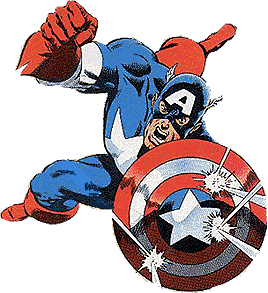
|
|
|
|
|
|
Captain America

|
|
|
|
|
|
Captain America
 Marvel's
biggest success during the Golden Age, and one of the top selling super heroes
of all time, Captain America is, first and foremost, a manifestation of
patriotism. His debut preceded his country's entry into World War II, and he
rode the wave of public spirit that followed Pearl Harbor; thus he identified
himself forever with a period that may have been the Golden Age of the United
States as much as it was the Golden Age of comic books. Sentimentally, a certain
nostalgia for the period remains, even among those who are too young to have
experienced its triumphs and tragedies firsthand.
Marvel's
biggest success during the Golden Age, and one of the top selling super heroes
of all time, Captain America is, first and foremost, a manifestation of
patriotism. His debut preceded his country's entry into World War II, and he
rode the wave of public spirit that followed Pearl Harbor; thus he identified
himself forever with a period that may have been the Golden Age of the United
States as much as it was the Golden Age of comic books. Sentimentally, a certain
nostalgia for the period remains, even among those who are too young to have
experienced its triumphs and tragedies firsthand.
When the war ended, Captain America seemed to lose his purpose. Within a few years that he was retired, and a short lived revival in the 1950's seemed to confirm fears that he had become irrelevant. His successful return in the 1960's, however, ingeniously took advantage of the problem: Captain America was portrayed as a relic of a less complicated era awakened like Rip Van Winkle. Now his quest for identity and direction are the themes of his adventures; he seeks the meaning of freedom in a time where patriotism may not be quite the same thing as unquestioning loyalty to political leaders.
Of course Cap has always been wrapped in the American flag, yet he is best symbolized by the shield he carries. Creators Joe Simon and Jack Kirby originally designed it to be triangular, but soon after made it round instead. It represents both defense and target, and when thrown like a discus, it also functions as a surprisingly effective weapon. A safeguard that draws fire and then fights back, the shield is the perfect emblem for Captain America.


Disclaimer: This page is not officially connected in any way to the Marvel Entertainment Group, Inc. All or any images used are scanned from Marvel Comics and are the property of Marvel Entertainment Group, Inc. and are used without permission. All info from: "Marvel: Five Fabulous Decades of the World's Greatest Comics